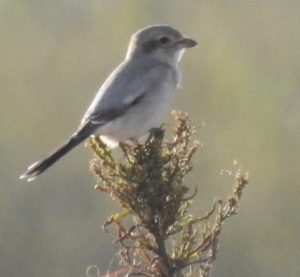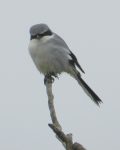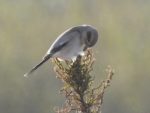
Whenever Harold Reeve has a few minutes away from family, work, and church, he generally squeezes in a little birding. He’s been compiling lists of Stanislaus County birds for over thirty years, including lists of nesting birds, wintering raptors, and, most especially, all species ever present in the county.
Late last Saturday afternoon, Reeve had a few minutes before a concert in Denair. He decided to drive east and look for an open space between almond orchards. When he found a patch of irrigated pastureland at the intersection of East Monte Vista Avenue and Hall Road, he turned north on Hall Road and parked near an irrigation ditch.
Almost immediately, Reeve saw a shrike perched high in a cottonwood tree. Whenever hard-core California birders see a shrike, their focus sharpens in hopes of identifying a rare Northern Shrike. In Reeve’s case, the focus sharpened a lot, because he knew Stanislaus County was long overdue for a visiting Northern Shrike, a bird occasionally but sporadically seen in the Central Valley, most often farther north than Stanislaus County.
The expected shrike species throughout California is the Loggerhead Shrike. The Northern Shrike is very similar, but only a rare winter visitor. It’s slightly larger and has a smaller “mask” than the Loggerhead Shrike; its usual wintering grounds are in southern Canada and the northern United States.
Most of the Northern Shrikes seen in California are immature and haven’t yet attained adult plumage; they’re more easily separated from Loggerhead Shrikes than adults because of pale, brownish upperparts and a barred breast and belly.

Almost as soon as Harold Reeve saw the shrike in the cottonwood tree, it flew and perched on a distant weed near the irrigation ditch, over a hundred yards away. Reeve thought at once that the shrike appeared too pale for a Loggerhead Shrike, and when he located the bird with his binoculars, he thought it a good candidate for Stanislaus County’s first confirmed record of Northern Shrike.
Like many other birders today, Reeve carries a superzoom lens camera. Knowing he had little time, Reeve grabbed his camera, zoomed way out, and took a short series of shots of the distant bird. Then, running late, he jumped in his car and drove to Denair.
As soon as he got home, Reeve downloaded the images of the shrike. Though fuzzy, they validated his initial impression: He had confirmed Stanislaus County’s first record of Northern Shrike.
Typically cautious, Reeve sent a late night email to fellow birding fanatics in Stanislaus County. The email included images he said, “I believe to be an immature Northern Shrike.”

Early next morning, Reeve, his wife Sharon, and several of Stanislaus County’s most fervent birders showed up on Hall Road, hoping to add a Northern Shrike to their county bird lists. After almost two hours, the bird was found perched in a lone willow tree about a quarter mile southeast of where Reeve had first seen it. At least half a dozen birders were able to locate the bird and add it to their lists.
Thirty years ago, the official Stanislaus County bird list wasn’t much over 250 species, mostly because no one had ever taken the time to confirm and record sightings, especially sightings of birds from faraway places. Thanks in large part to over thirty years’ diligence by Harold Reeve, the Stanislaus County bird list now comprises 320 species, many of them first sighted and confirmed by Reeve himself, who is already looking for number 321. If he gets enough time away and finds enough open space, he’s very likely to find it.
